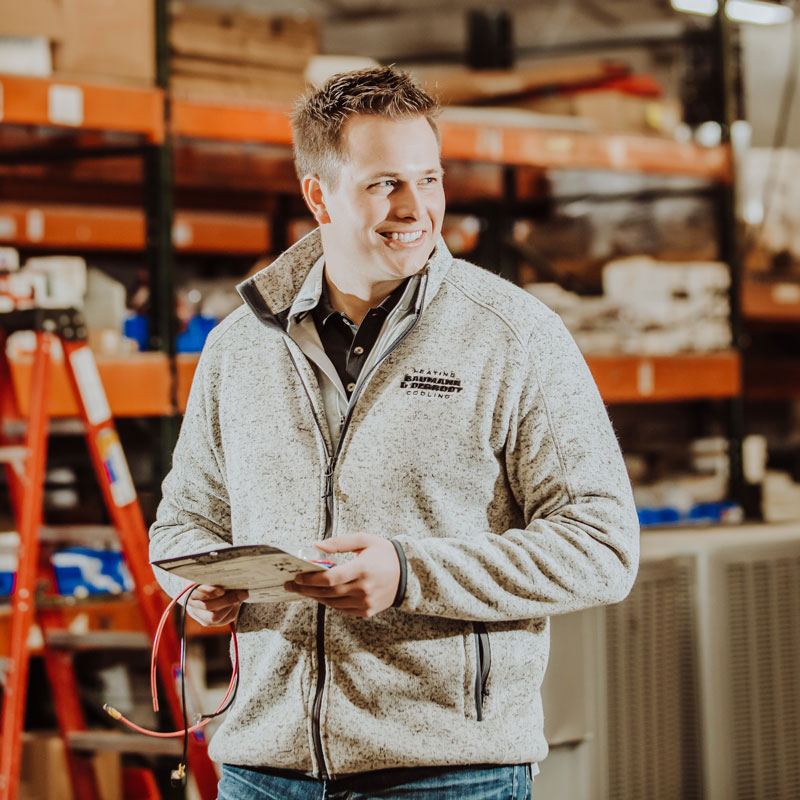Navigating the world of HVAC systems can be confusing, especially if you’re unfamiliar with the industry’s technical lingo. In this video, Chad Baumann, co-owner of Baumann & DeGroot Heating and Cooling, breaks down some of the most common HVAC terms that homeowners encounter when upgrading or replacing their systems.
Common HVAC Terms in Heating Systems
Efficiency: What Does It Really Mean?
When it comes to heating equipment, one of the most common differences between systems is efficiency. Efficiency refers to how much heat is actually staying inside the structure. Chad explains that heaters fall into two categories:
- Standard Efficiency (non-condensing): Below 85% efficiency. These systems have hotter exhaust gases that vent outside before condensation occurs.
- High Efficiency (condensing): Above 85% efficiency. These systems retain more heat, which causes the cooler exhaust to condense.
System efficiency is measured in percentages, with the dividing line being roughly 85%. Anything below that qualifies as a standard efficiency unit, whereas anything above is high efficiency. Traditional heating systems, standard efficiency, are non-condensing. Their exhaust gasses are extremely hot and vent outside before condensation occurs. However, this process removes a significant amount of energy that could otherwise be used for heating. On the other hand, high-efficiency systems retain more heat, causing the exhaust gases to cool and condense into water. This retained heat can be used to further heat your home, while built-in drains collect and dispose of the water.
Single-Stage, Two-Stage, and Modulating Furnaces
A properly sized furnace needs to be large enough to maintain 70 degrees on the coldest day of the year. In Michigan, that might be 2 degrees or colder. However, the majority of our winter is spent in the 20s and 30s, which means a furnace is often oversized for typical days. To handle this, furnaces come with different staging options:
- Single-Stage: This type of furnace is like a light bulb, either fully on or fully off. When turned on, the furnace runs at full capacity until the thermostat is satisfied and shuts off.
- Two-Stage: Instead of only running at full capacity, a two-stage furnace has two levels of heat output. Most time is spent in the first stage, running at about 70% capacity. The gas valve releases less fuel, and the blower slows to match that. If the thermostat is not satisfied after a set period, typically 7 to 14 minutes, the system shifts to the second stage and runs at 100% capacity.
- Modulating: This is the most advanced option. Rather than running in set stages, a modulating furnace is able to adjust heat output anywhere from 40% to 100% capacity. It continually adapts based on past heating cycles to maximize comfort, efficiency, and long run cycles.
Standard vs Communicating Systems
- Standard Systems: Similar to flipping a switch, the thermostat in a standard system sends basic on and off signals. It tells components when to start and stop, but does not adjust for changing conditions.
- Communicating Systems: This system functions more like a smart home network. All components (thermostat, furnace, outdoor unit) continually communicate with each other. They analyze indoor and outdoor temperature, humidity, and more to determine which components are needed and at what capacity. This results in finely tuned performance, better efficiency, and improved comfort.
Common HVAC Terms in Cooling Systems
If you’re shopping for air conditioners or heat pumps, you’ll come across two key terms:
- BTU: A British Thermal Unit is the amount of energy needed to raise the temperature of one pound of water by one degree Fahrenheit. It’s a standard unit used to measure both heating and cooling capacity.
- Tonnage: Refers to cooling capacity. One ton equals 12,000 BTUs (British Thermal Units), which is the amount of heat removed per hour.
- SEER (Seasonal Energy Efficiency Ratio): Measures how efficiently a unit cools your home over a season. The higher the SEER, the less energy it consumes for the same amount of cooling.
What about brands? Is there a difference?
Baumann & DeGroot works with trusted brands like Amana and Carrier. While Chad notes there are minor differences and standout years for certain manufacturers, overall quality is very similar across the top brands. The real difference comes down to proper sizing, installation, and maintenance.
Want to Learn More? If you’re feeling more confident in your HVAC knowledge or are ready to explore new system options, contact Baumann & DeGroot at (616)396-4328 or schedule online. We’re happy to guide you every step of the way.

